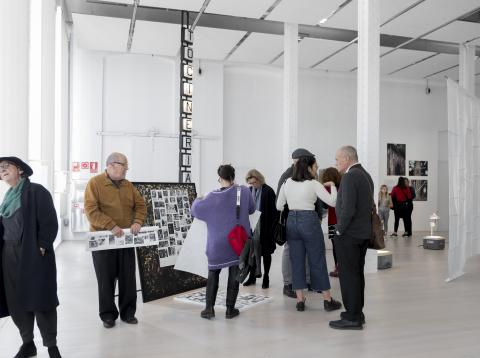It Happens Every Day
Artist: Jordi Mitjà
Dates: 15 February - 27 September 2020 (August: closed)
Exhibition Opening: 15 February, at 12.00
Where: Ground Floor and 1st Floor
Curated by Joana Hurtado Matheu
Notice: this exhibition is extended until October 11, 2020. Due to the current health situation by COVID-19, the video pieces Artificial and Traduçoes do original have been temporarily canceled, which can be viewed online here and here, respectively.
Of all the loads that stones have to bear, that of the metaphor is the heaviest. Foundational in construction and decorative of humanity, we have chipped them for hunting and survival; we have put them together to make walls that separate and roofs that unite; we have exalted and collected them, giving them forms and legends that have made them talk.
We have used them to build a world of allegories: leave no stone unturned, the rolling stones that gathered no moss but made music; the boulder of Sisyphus we carry, forever untiring; or the one that causes us to stumble and fall, over and over, always the same, always different. There are anonymous stones and stones with names. There are marginal stones, like you, little pebble, humble protagonist of a poem, which suddenly gives a voice to great revolutions: from slingshots to cobblestones, the victory against Goliath. There are also precious and chosen stones, such as the Rosetta Stone, the Black Stone of Kaaba and the tablets with the Ten Commandments – stones that move the masses... And masses of stone that no one knows how they ended up where they are: from menhirs to obelisks, from megalithic groupings to telluric rocks, the appropriation of these stones has helped us give meaning to a date or an inexplicable event.
The most paradigmatic case is that of foundation stones. The first that is laid when constructing a building has everything: anonymity, uniqueness and superstition; the past and the future in one single stone. As an omen of strength, this act of burying to project is a tradition that stems from the religious sphere and has been adopted by civil society, replacing the consecration by bishops with a photo of politicians. We have gone from one stone to another, from one image to another, following in the footsteps of the humanistic parable, but from the symbol to the fetish it is the literalism of the illusion that has been buried.
In order to question this weight of the metaphor that encumbers stones, Jordi Mitjà makes them fly. And he does so by expanding the paradox, widening the distance between opposites to display all the nuances and tensions that lie in-between. Exposing contradictions means leaving suspended any meaning, showing the wonderful precariousness on which our imagination dances. The artist disrupts the message so that we look at the subject and the form, posing questions about our relationship with the environment, from a simple stone to the avalanche of images that speak to us, every day, from all sides.




